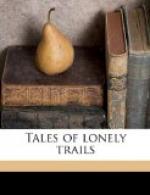[Illustration: The wind-worn treacherous slopes on the way to Nonnezoshe]
It seemed that both man and beast must slide down to where the slope ended in a yawning precipice. Chub was snorting or screaming in terror. Our mustangs were frightened and rearing. It was not a place to have trouble with horses.
I had a moment of horrified fascination, in which Chub turned clear over. Then he slid into a little depression that, with Joe’s hold on the lasso, momentarily checked his descent. Quick as thought Joe ran sidewise and down to the bulge of rock, and yelled for help. I got to him a little ahead of Wetherill and Nas ta Bega; and together we pulled Chub up out of danger. At first we thought he had been choked to death. But he came to, and got up, a bloody, skinned horse, but alive and safe. I have never seen a more magnificent effort than Joe Lee’s. Those fellows are built that way. Wetherill has lost horses on those treacherous slopes, and that risk is the only thing about the trip which is not splendid.
We got over that bad place without further incident, and presently came to a long swell of naked stone that led down to a narrow green split. This one had straight walls and wound away out of sight. It was the head of a canyon.
“Nonnezoshe Boco,” said the Indian.
This then was the Canyon of the Rainbow Bridge. When we got down into it we were a happy crowd. The mode of travel here was a selection of the best levels, the best places to cross the brook, the best places to climb, and it was a process of continual repetition. There was no trail ahead of us, but we certainly left one behind. And as Wetherill picked out the course and the mustangs followed him I had all freedom to see and feel the beauty, color, wildness and changing character of Nonnezoshe Boco.
My experiences in the desert did not count much in the trip down this strange, beautiful lost canyon. All canyons are not alike. This one did not widen, though the walls grew higher. They began to lean and bulge, and the narrow strip of sky above resembled a flowing blue river. Huge caverns had been hollowed out by water or wind. And when the brook ran close under one of these overhanging places the running water made a singular indescribable sound. A crack from a hoof on a stone rang like a hollow bell and echoed from wall to wall. And the croak of a frog—the only living creature I noted in the canyon—was a weird and melancholy thing.
“We’re sure gettin’ deep down,” said Joe Lee.
“How do you know?” I asked.
“Here are the pink and yellow sego lilies. Only the white ones are found above.”
I dismounted to gather some of these lilies. They were larger than the white ones of higher altitudes, of a most exquisite beauty and fragility, and of such rare pink and yellow hues as I had never seen.




